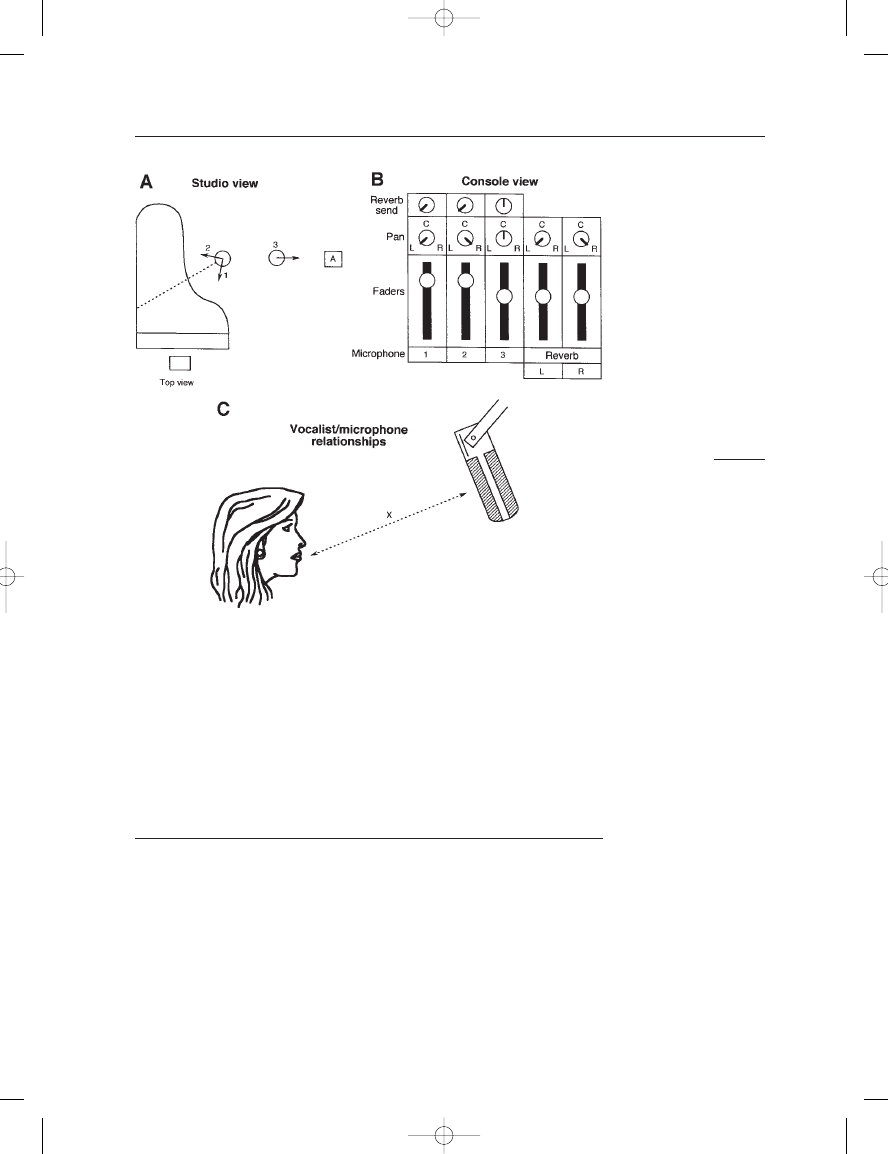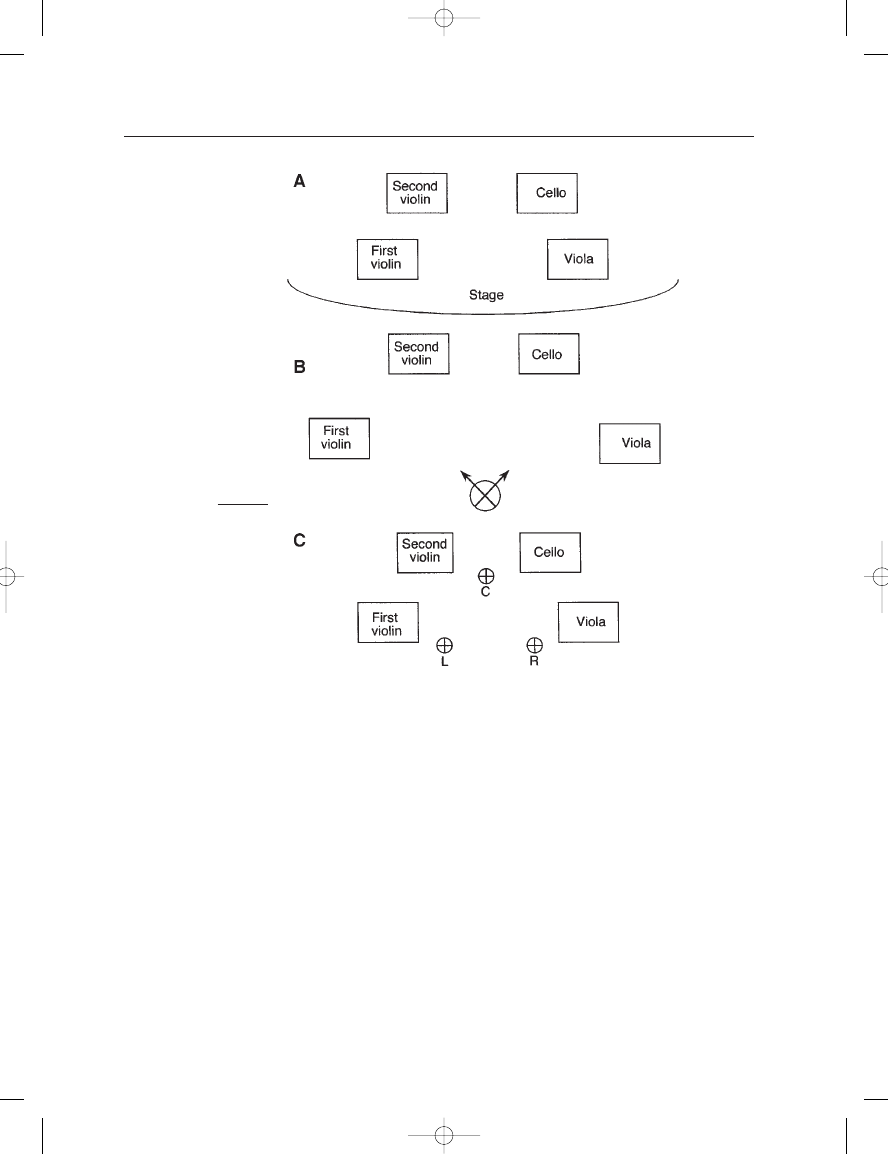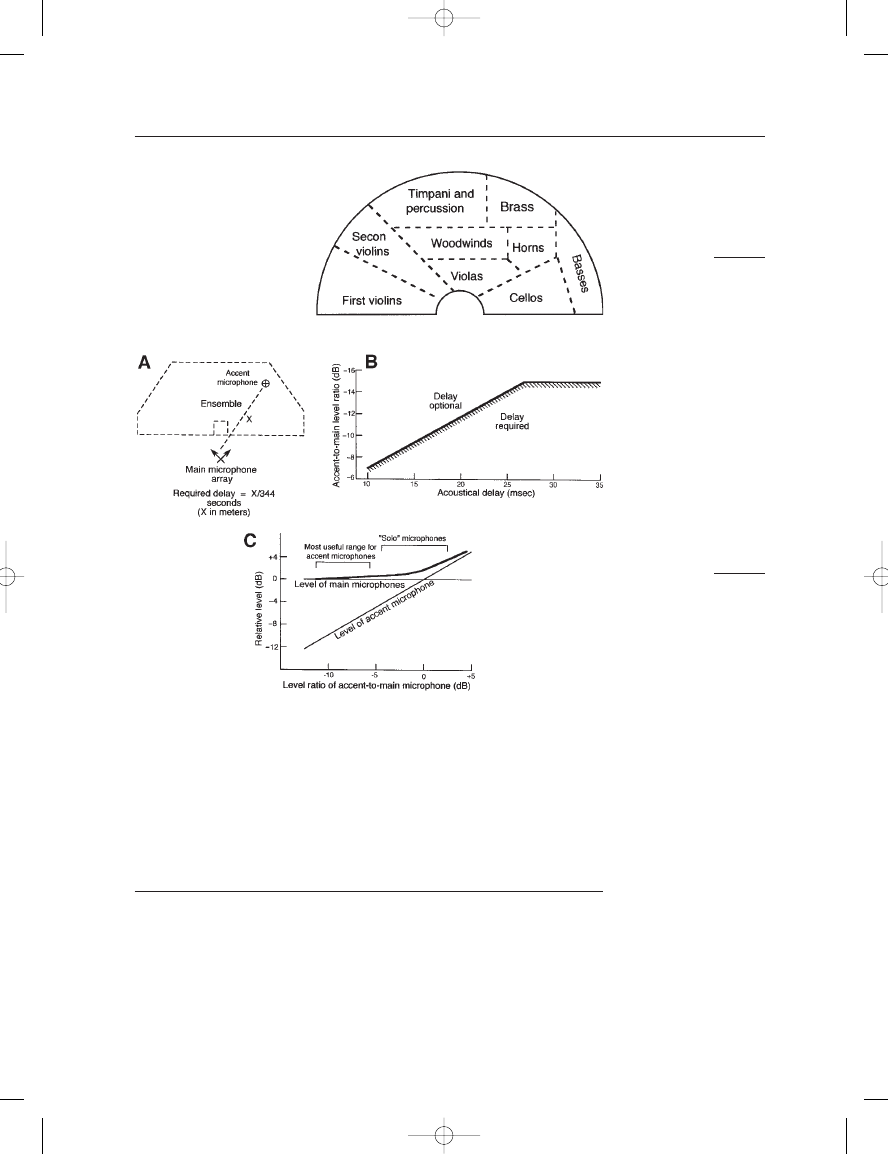ВУЗ: Казахская Национальная Академия Искусств им. Т. Жургенова
Категория: Книга
Дисциплина: Не указана
Добавлен: 03.02.2019
Просмотров: 17300
Скачиваний: 51

for a coincident pair, perhaps with an additional flanking omnidirec-
tional pair. This approach will make the ensemble sound “staged”; that
is, the listener will hear the group with a “Row G” perspective. If more
intimacy is desired the group can be placed in an arc or even a circle,
with microphones more closely placed. Figure 13–8 illustrates both
approaches. At A we see a piano trio (piano, violin, and cello) in a nor-
mal concert setup, with a frontal array of microphones. At B we show
an alternate approach of positioning the violin and cello players so that
all three members of the group now have direct eye contact. (See
Compact Disc Reference 4.)
A typical listener reaction to these two recording perspectives is that
the former places the listener in the concert hall (“you are there”), while
the latter places the performers in the listener’s living room (“they are
here”). The players, once they have adjusted to the alternate seating, usu-
ally become partial to it. The engineer and producer favor it because it
gives them more flexibility in establishing and altering balances as the
recording gets underway.
Recording a solo instrument or vocalist with piano is greatly helped
by departing from the concert setup, as shown in Figure 13–9. Here, the
vocalist has been placed a comfortable distance from the piano and is fac-
ing the pianist, thus ensuring good eye contact. Both piano and soloist are
individually picked up in stereo, and a mix is created in the control room.
If good judgments are made in balance and placement, everything will
sound perfectly natural. This approach allows the engineer and producer
to achieve the desired balance between soloist and piano at all times.
The question of when to use the piano with its cover on half-stick
often comes up quite often. In concert, half-stick may be necessary to
keep the instrument from overpowering soloists. However, in the studio
environment, it is preferred to keep the cover at full-stick and achieve the
necessary balances purely through placement of microphones and per-
formers. (See Compact Disc Reference 5.)
The string quartet is one of the most enduring musical ensembles of
all time, and the medium has a rich and complex repertoire that continues
to grow. Normally the players are seated as shown in Figure 13–10A.
While the traditional frontal coincident array is often used, as shown at
B, many engineers favor an array of spaced omnidirectional microphones,
13: Classical Stereo Recording Techniques and Practice
203
FIGURE 13–8
Recording the piano trio:
concert setting (A); studio
setting (B).
Earg_13.qxd 14/9/04 2:53 PM Page 203

as shown at C. The center microphone would normally be mixed in at a
level about
4 to 6 dB relative to the two others and panned just
slightly right of center. Its purpose is to anchor the center of the stereo
stage (primarily the cello) without appreciably narrowing the overall
stereo stage width. Many engineers use a cardioid microphone for the
center pickup. The two flanking omnis should be positioned so that they
preserve the balance of the entire group. (See Compact Disc Reference 6.)
THE CHAMBER ORCHESTRA; INTRODUCTION TO
ACCENT MICROPHONES
The chamber orchestra normally numbers from 25 to 40 players,
depending on the repertoire. The majority of the literature for the cham-
ber orchestra is from the late 18th and early 19th centuries. The ensem-
ble is best recorded with four microphones across the front, as discussed
in the previous chapter, with the addition of accent microphones as
needed. Accent microphones, also familiarly called “spot mikes”, are
used to add presence to an instrument or an orchestral section without
necessarily increasing loudness. On a small reflective stage they may not
be needed at all. But under most conditions we would use a secondary
THE MICROPHONE BOOK
204
FIGURE 13–9
Recording vocalist with
piano in the studio:
microphone positions (A);
console assignments (B);
vocalist’s orientation to
microphone (C); distance x
is normally in the range of
0.5 m (20 inches) to 1 m
(40 inches) (C).
Earg_13.qxd 14/9/04 2:53 PM Page 204

coincident stereo pair for picking up the woodwind section, along with
single accent microphones for the first two stands of bass viols, harp and
celesta. The timpani are normally loud enough, but an accent microphone
may help bring out the articulation of the drums. A typical seating
arrangement is shown in Figure 13–11. (See Compact Disc Reference 7.)
Accent microphones are normally cardioids and are generally mixed
into the main array at levels according to the technique shown in
Figure 13–12. Many engineers prefer to delay individually all of the
accent microphones so that their signals will be essentially time-coherent
with the pickup of the main pair, as shown at A. That is, if an accent
microphone is located, say, 8 m from the main pair, it may be delayed by
8/344 seconds, or about 23 ms, to align the pickup with its acoustical
signal path to the main pair. While it is always correct to delay accent
microphones, it may not be necessary because of the masking effect of
the louder pickup from the main microphone array. Data shown at B
indicate approximately when delay is mandatory, while data shown at
C show the approximate level relationships between accent microphones
and main microphones.
13: Classical Stereo Recording Techniques and Practice
205
FIGURE 13–10
Recording the
string quartet; normal
concert seating (A); use
of coincident or
near-coincident
microphones (B); use of
spaced omnidirectional
microphones with an
accent microphone for the
cello (C).
Earg_13.qxd 14/9/04 2:53 PM Page 205

Remember that it is very important to pan the positions of the accent
microphones so that they correspond exactly to the physical position of
the instruments as heard on the stereo stage when no accent micro-
phones are engaged. It is also common practice to attenuate slightly the
low frequency response of the accent microphones; this makes it easier
to add presence without adding loudness.
THE LARGE ORCHESTRA
The full symphony orchestra may have a complement of strings of
14-12-10-8-8 (respectively, the number of first violins, second violins,
violas, cellos, and basses). Woodwinds may number from 8 to 16,
depending on the nature of the score. French horns may number any-
where from 4 to 12, depending on the score, and the heavy brass may
number 4 trumpets, 3 trombones, and a single tuba. The percussion
THE MICROPHONE BOOK
206
FIGURE 13–11
Recording the chamber
orchestra; normal seating
arrangement.
FIGURE 13–12
Implementing accent
microphones: calculating
microphone delay (A);
determining when delay is
and is not essential (B); level
range for accent
microphones (C).
Earg_13.qxd 14/9/04 2:53 PM Page 206

resources, including timpani, may call for 4 players. Add to all of this the
requirements of perhaps two harpists and a keyboard player (celesta
and/or piano), and the head count can easily reach or exceed 90 players.
A symphony orchestra takes up much floor space, and a good rule is
to multiply the number of players by two to arrive at the approximate
number of square meters of total occupied floor space, taking into
account a normal complement of players in each section. Many modern
stages are not quite large enough to fit this paradigm, and many orches-
tral recordings routinely take place instead in large, fairly reverberant
ballrooms or other large meeting spaces. This is especially true in
England and on the European continent. Churches are often called into
duty for large-scale recording, but the excessive reverberation time of
many of these venues can be a problem.
MICROPHONE PICKUP ANALYSIS
Figure 13–13 shows plan and side views of the recording setup for a live
(with audience) recording of Gustave Holst’s “The Planets”, a typical
large orchestral work dating from 1916. Note that there are 14 micro-
phones. Of these, the four across the front provide the basic pickup; all
others are accent microphones.
The main four microphones consist of an inner ORTF pair with a
flanking pair of omnidirectional microphones. The ORTF pair is aimed
downward at a point about two-thirds the depth of the stage, and the
intent here is to avoid picking up too much of the front of the orchestra
by relying on the off-axis attenuation of the cardioid patterns to balance
the front-back distance ratio.
The accent microphones are detailed below:
1. Harps: two instruments with a single cardioid placed between them.
2. Celesta: a single cardioid to delineate this soft instrument.
3. Horns: a single cardioid placed about 4 m (13 ft) above the section
and aimed downward toward the edge of the bells.
4. Woodwinds: an ORTF pair aimed at the second (back) row of
players.
5. Timpani: two sets of drums were used, and a single cardioid micro-
phone was placed midway between them about 2.5 m (8 ft) above
the stage.
6. Brass: a single cardioid placed about 4 m above the players, aimed
downward.
7. Basses: a single cardioid placed overhead about 1.5 m (5 ft) from
the first stand of players.
8. House pair: two widely spaced cardioids hanging from the attic and
positioned about 7 m (23 ft) above the audience and about 8 m
(26 ft) from the edge of the stage. These microphones were aimed
at the upper back corners of the hall.
13: Classical Stereo Recording Techniques and Practice
207
Earg_13.qxd 14/9/04 2:53 PM Page 207